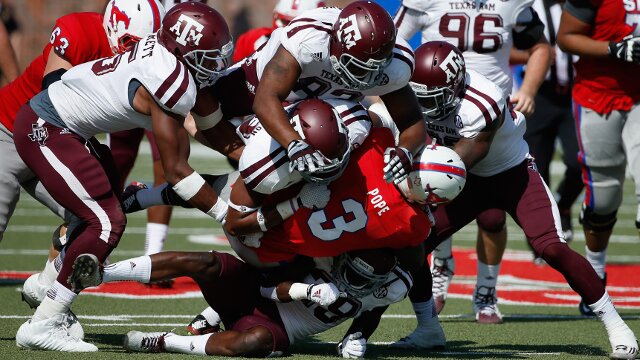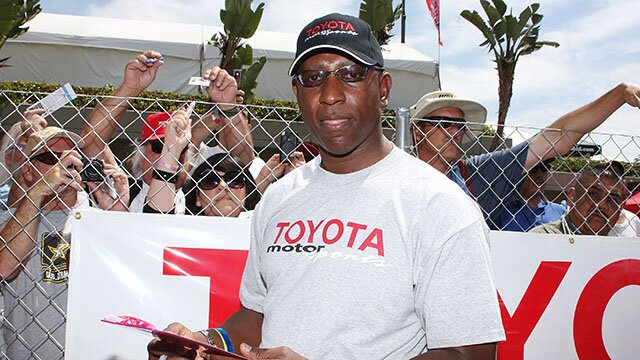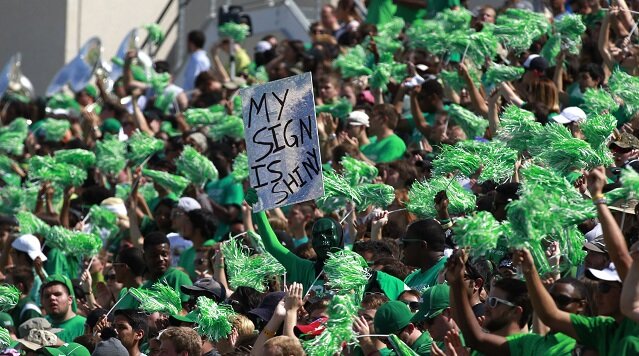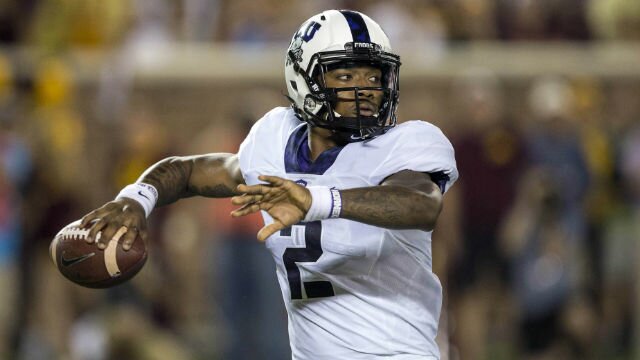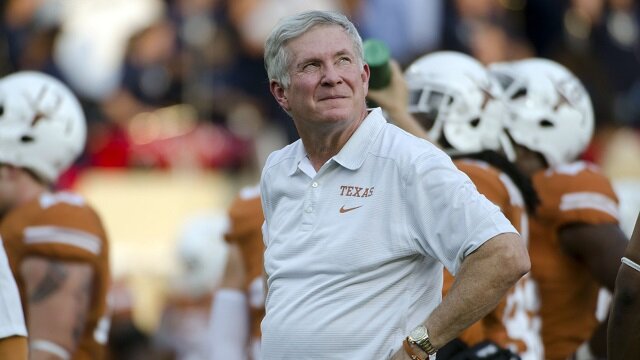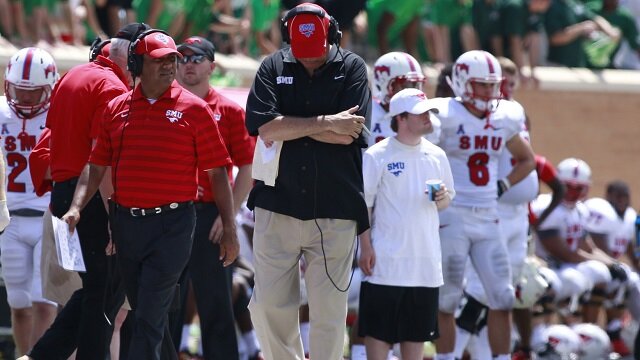
At one time, the SMU Mustangs were one of the best college football programs in the country. But an investigation into the shady dealings of boosters, including providing cash and cars to recruits and players, resulted in a historic “Death Penalty” from the NCAA which shut the football program down for the 1987 and 1988 seasons.
When the team was allowed to return to the field, they were a shadow of their former selves and the team wallowed in mediocrity (at best) for years. While things appeared to be on the right track for SMU to move into the conversation of top non-power conference teams, the wheels have completely fallen off of the Mustangs program in 2014, leading many to think that SMU is once again circling the drain towards college football obscurity.
The disastrous start to 2014 is particularly troubling for SMU fans because the pieces appeared to be in place to build the program into a consistent winner in the AAC, starting with head coach June Jones. After turning the Hawaii Warriors into a BCS-qualifying team in 2007, Jones came to the mainland to take on the challenge of revitalizing the once-proud program of the Mustangs. After limping to a 1-11 record in his first season with a roster that was lean on talent, Jones got things going in 2009, leading SMU to a 8-5 record including a 45-10 win in the Hawaii Bowl over the Nevada Wolfpack. The win snapped a 25-year bowl drought for SMU in a big way and started a culture change within the program.
Jones would go on to lead SMU to four straight bowl games from 2009-2012 and had some great momentum in turning the Mustangs into contenders for the AAC title. Injuries took their toll on the team, however, in 2013 and the program missed the postseason for just the second time under Jones after finishing 5-7. The team dropped the final two games of last year to miss out on making a fifth straight bowl game, including a 34-0 loss to the Houston Cougars in the second-to-last regular season game. It was the first time in Jones’ illustrious coaching career that one of his “run and shoot” teams had been held scoreless. As it turns out, that game may have just been a preview of what was to come.
With no Garrett Gilbert under center, the SMU offense has looked completely lost through the first two weeks of the season. Neal Burcham, who saw some spot starts as a freshman in 2013 in place of an injured Gilbert, struggled to lead the offense as he completed just 27-of-48 passes for 158 yards with no touchdowns and two interceptions while getting sacked six times. Not surprisingly, the SMU offense has sputtered with that kind of production under center, scoring just one touchdown as they have been outscored 88-6 in losses to the Baylor Bears and North Texas Mean Green. To make matters worse offensively, Burcham has been lost for the rest of the season with an elbow injury, putting freshman Kolney Cassel into the starting lineup (though he looked better in relief of Burcham against North Texas, throwing for 134 yards and a touchdown).
That doesn’t even take into account the turmoil happening on the sidelines. Following their blowout loss to the Mean Green, Jones abruptly resigned, effective immediately, for “personal reasons” that he said he needed to deal with. This comes on the heels of the school signing Jones to a rich extension this offseason that was supposed to keep the coach on the sidelines through 2017. Now, the program is without the architect of their rebuilding effort in Jones, who athletic director Rick Hart described as “one of the most influential individuals on SMU football since it returned to the Hilltop in 1989,” with a roster that is clearly not ready to compete with anyone if we are to believe what we’ve seen in the first two weeks of the season.
The result has been SMU making headlines for all the wrong reasons and raising the ire of some of the more illustrious alumni. Former SMU running back and Pro Football Hall of Famer Eric Dickerson has had a tumultuous relationship with his alma mater over the years. Coming out from under the death penalty, the school tried to distance itself from players associated with the scandal while playing there during the 1980s. But recently, the Mustangs have started to open their doors again to their former greats to try and rekindle some support from the fan base and Dickerson has been passionate about seeing his former team return to respectability.
But with all that has gone wrong to start the 2014 season, Dickerson is making his displeasure known. In comments made to 105.3 KRLD-FM in Dallas, the former Heisman Trophy finalist said that he and some other former players feel that if this is the best that Southern Methodist University can do to build their football program, “Just stick to academics and basketball and kill that program.” For a program that had to be resurrected once already, those are heavy words to hear from your most famous alumni.
Dickerson’s point, however, holds some truth to it. SMU sits in the heart of college football recruiting and they have not been able to build up a roster that can consistently compete at a high level. Some will continue to talk about the lasting effects of the death penalty but that’s no longer a valid excuse not to be improving. The NCAA’s heavy-handed punishment was lifted 25 years ago, before any player currently on the roster was even born, and plenty of other programs have risen up during that time while SMU spun its wheels.
The TCU Horned Frogs went from small-time program to BCS busting mid-major and eventually earned an invite into the Big 12 as a power conference team. The UTSA Roadrunners have existed for only a few years but they have already put together a highly-competitive team that will challenge for the Conference USA title this season. Even North Texas, who just routed the Mustangs last week, is a team on the rise.
All around them, programs are being built up with rapid success while SMU has started to slip backwards in part, according to Dickerson, from a lack of support from “upper management” in the university. Dickerson believes that Jones’ resignation stems from frustration with the school not investing in their football program enough, perhaps out of fear of losing control of it like they did before getting hit with the death penalty. While the school ponied up to pay Jones this offseason, the facilities and attendance continue to lag behind as the university seemed intent on watching Jones spin barely winning seasons out of patchwork rosters.
If SMU is not committed to fully restoring the football program, then maybe Dickerson is right to suggest they shut it down. To win in today’s college football landscape, a university must be fully committed to the program. Without that unwavering support, the Mustangs risk sliding all way to the bottom of the Texas college football program hierarchy. And that distinction might be even worse than death.
You can follow me on Twitter @ATylerBrett, on Facebook and on Google
 Share
Share 

